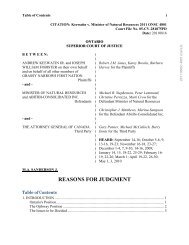Directive 065: Resources Applications for Oil and Gas Reservoirs ...
Directive 065: Resources Applications for Oil and Gas Reservoirs ...
Directive 065: Resources Applications for Oil and Gas Reservoirs ...
Create successful ePaper yourself
Turn your PDF publications into a flip-book with our unique Google optimized e-Paper software.
Requirements<br />
Comments<br />
7) Where drainage is alleged, a discussion<br />
including<br />
a) evidence showing that the reserves<br />
underlying your l<strong>and</strong>s have been drained<br />
subsequent to the completion of your<br />
well in the pool, <strong>and</strong><br />
b) an estimate of the total amount of<br />
inequitable drainage that has occurred<br />
from your l<strong>and</strong>s since your well was<br />
completed in the pool, together with<br />
details of how the drainage was<br />
calculated.<br />
In cases where a well has remained shut in,<br />
drainage may be confirmed by summarizing<br />
at least two pressure tests taken on the well.<br />
If you are arguing that your currently<br />
producing well is not producing at sufficient<br />
rates to recover an equitable share of<br />
production, a<br />
comparison may be made between the actual<br />
produced volume from the well <strong>and</strong> the<br />
volume the well should have produced to<br />
obtain an equitable share of production. You<br />
should present a detailed calculation showing<br />
how you determined your equitable share of<br />
production.<br />
8) A discussion of your proposal as to how the<br />
ERCB should restrict or distribute<br />
production from the pool that includes<br />
a) a tabulation of the proportion of<br />
production or rate of production that<br />
each well or group of wells should be<br />
allowed to produce, together with the<br />
details of how the proposed<br />
production scheme was obtained, <strong>and</strong><br />
b) if considered appropriate, the total<br />
production rate proposed <strong>for</strong> the pool,<br />
together with the details of how this<br />
rate was determined <strong>and</strong> why such a<br />
rate should be set, <strong>and</strong><br />
c) if specific rates are proposed under item<br />
8(a),<br />
i) an indication of why rates, rather<br />
than a percentage allocation, are<br />
being proposed,<br />
ii) whether the proposed rates are<br />
economic <strong>for</strong> each well or group of<br />
wells, <strong>and</strong><br />
iii) whether each well or group of wells<br />
would be capable of producing at<br />
the proposed rate.<br />
The ERCB usually distributes production<br />
among wells in a pool on a percentage basis,<br />
rather than setting any specific rate or<br />
volume. The proportion of production<br />
allocated to each well is commonly based on<br />
the following <strong>for</strong>mula:<br />
Percentage of pool production <strong>for</strong> specific<br />
well = 100 x (wellbore net pay x porosity x<br />
gas saturation x area of spacing unit or<br />
validated area <strong>for</strong> specific well)/(sum of<br />
wellbore net pay x porosity x gas saturation x<br />
area of spacing units or validated areas <strong>for</strong><br />
all wells)<br />
<strong>Directive</strong> 032 <strong>and</strong> Decision 91-8 discuss the<br />
ERCB’s commonly used allocation <strong>for</strong>mula<br />
<strong>and</strong> the validated area concept.<br />
The ERCB has not commonly used mapping<br />
as a means to determine hydrocarbon pore<br />
volume in a spacing unit because in many<br />
cases such mapping is highly interpretative.<br />
The ERCB has not normally factored the<br />
deliverability of a well into an allocation<br />
<strong>for</strong>mula to avoid disputes on what constitutes<br />
appropriate well testing. You may propose an<br />
allocation <strong>for</strong>mula other than the commonly<br />
used one; however, you should include<br />
detailed justification as to why the ERCB<br />
should deviate from its usual practice in<br />
determining an allocation <strong>for</strong>mula.<br />
1-4 • ERCB <strong>Directive</strong> <strong>065</strong>: <strong>Resources</strong> <strong>Applications</strong> / Rateable Take (October 2011)
















